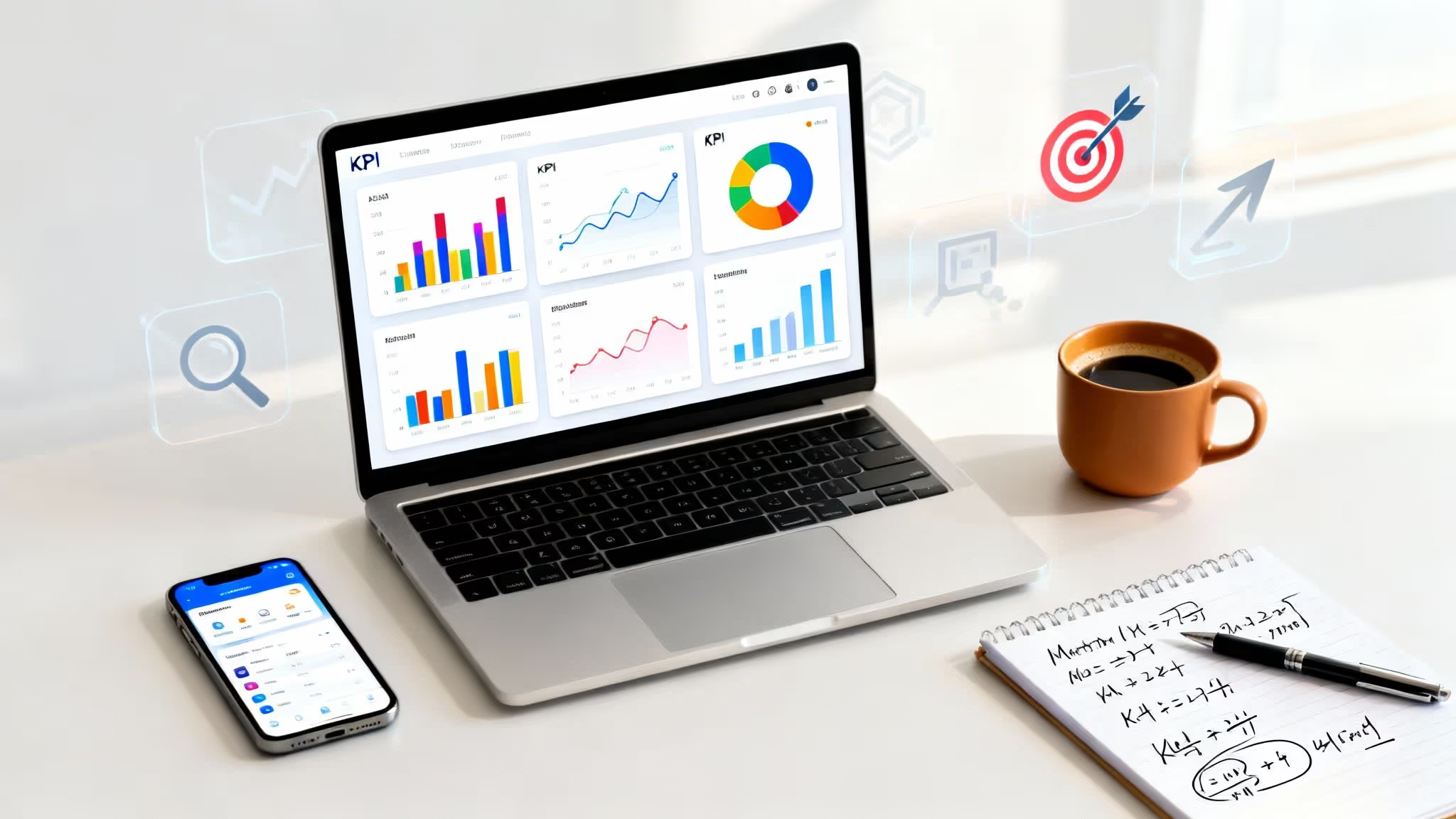The B2B SaaS market is fiercely competitive, demanding more than just a great product to succeed. Sustainable growth hinges on a sophisticated, multi-channel approach built on proven B2B SaaS marketing strategies. While countless articles offer surface-level tips, real progress requires a deeper dive into the frameworks that consistently deliver measurable results. This is where many marketing teams falter, either chasing fleeting trends or sticking to outdated playbooks that no longer resonate with today's informed buyers.
This comprehensive roundup moves beyond generic advice. We will dissect nine potent strategies that high-growth SaaS companies use to attract, engage, and retain high-value customers. You won't find vague suggestions here. Instead, we provide a blueprint for execution, covering everything from establishing thought leadership with content marketing to implementing precision-targeted Account-Based Marketing (ABM) campaigns and fostering organic growth through Product-Led (PLG) models.
Each strategy is broken down into actionable steps, illustrated with real-world examples, and analyzed for its unique advantages and potential challenges. Whether you're a founder striving for product-market fit or a marketing leader at an established firm, this guide offers the strategic clarity needed to build a resilient and effective marketing machine. Let’s dive into the strategies that truly work.
1. Content Marketing & Thought Leadership
Content marketing is a strategic approach focused on creating and distributing valuable, relevant, and consistent content to attract and retain a clearly defined audience. For B2B SaaS companies, this isn't just about blogging; it's about establishing your brand as an indispensable industry resource and a thought leader. The core principle is simple: instead of pitching your products, you provide genuine value that solves your audience's problems, which in turn builds trust and credibility.

This strategy excels because it aligns perfectly with the modern B2B buyer's journey. Prospects conduct extensive research before ever speaking to a sales representative. By providing high-quality educational content, you meet them exactly where they are, guiding them through the awareness, consideration, and decision stages. Effective SaaS inbound marketing hinges on this value-first approach. Learn more about how SaaS inbound marketing can accelerate your growth.
How to Implement This Strategy
- Build Topic Clusters: Instead of writing random blog posts, create a central "pillar" page for a broad topic (e.g., "Customer Onboarding") and surround it with more specific "cluster" articles (e.g., "Onboarding Email Templates," "Best Onboarding Software"). This structure signals expertise to search engines and provides a comprehensive resource for users.
- Leverage Original Research: Conduct your own studies, surveys, or data analysis to create unique, proprietary content. Reports like an annual "State of the Industry" can generate high-quality backlinks, media attention, and social shares, cementing your thought leadership status.
- Repurpose Content Intelligently: A single in-depth guide can be transformed into a webinar, a series of short videos, an infographic, and multiple social media posts. This maximizes the value of your initial investment and reaches different audience segments on their preferred channels.
A prime example is HubSpot, which built its empire on content. Its extensive blog, free certification courses via HubSpot Academy, and downloadable templates attract millions of marketing and sales professionals, creating a massive top-of-funnel pipeline that feeds directly into its software products. By educating the market, they simultaneously created demand for their solution.
2. Account-Based Marketing (ABM)
Account-Based Marketing (ABM) is a highly focused strategy where marketing and sales teams collaborate to target best-fit, high-value accounts with personalized campaigns. Instead of casting a wide net, ABM flips the traditional funnel. It starts by identifying specific target companies and then engages key decision-makers within them through coordinated, highly relevant messaging.

This strategy is one of the most effective B2B SaaS marketing strategies because it eliminates wasted resources on prospects who will never convert. By concentrating efforts on accounts with the highest revenue potential, companies see a significant increase in ROI, customer lifetime value, and deal size. It aligns marketing and sales on a shared goal, fostering a "one team" approach to revenue generation.
How to Implement This Strategy
- Establish Strong Sales & Marketing Alignment: ABM cannot succeed in a silo. Hold joint planning sessions to define your Ideal Customer Profile (ICP), select target accounts, and establish clear Service Level Agreements (SLAs). Both teams must agree on roles, responsibilities, and success metrics.
- Invest in Account Intelligence and Intent Data: Use tools like 6sense or Demandbase to gather deep insights into your target accounts. Identify their pain points, key stakeholders, and buying signals. Intent data is crucial for pinpointing which accounts are actively researching solutions like yours, allowing you to prioritize outreach effectively.
- Execute Personalized, Multi-Channel Campaigns: Create content, ads, and outreach tailored specifically to each target account or a small cluster of similar accounts. This could include personalized landing pages, direct mail with custom gifts, or account-specific ads on LinkedIn. The goal is to make your prospects feel understood.
A powerful example is Snowflake, the cloud data platform. They use a sophisticated ABM approach to land major enterprise deals. By deeply researching target accounts' technological infrastructures and business challenges, their marketing and sales teams craft bespoke messaging that speaks directly to a CIO’s specific needs, leading to massive contract wins.
3. Product-Led Growth (PLG)
Product-Led Growth (PLG) is a go-to-market motion where the product itself serves as the primary engine for customer acquisition, conversion, and expansion. Instead of relying on traditional sales-led motions, PLG allows users to experience the product's value firsthand through freemium plans, free trials, or interactive demos. The core idea is to show, not just tell, how your software solves a user's problem.

This strategy is highly effective for B2B SaaS because it dramatically shortens the sales cycle and reduces customer acquisition costs. When users can self-serve and validate a tool's utility on their own terms, the product essentially sells itself. This approach builds a user base of advocates who naturally drive viral growth by inviting colleagues, making PLG one of the most scalable B2B SaaS marketing strategies available.
How to Implement This Strategy
- Minimize Time-to-Value (TTV): Your onboarding process must guide new users to their first "aha!" moment as quickly as possible. Eliminate friction, provide clear in-app guidance, and focus on the core features that deliver immediate value.
- Embed Virality and Collaboration: Build features that encourage users to invite their teams. Slack's growth was fueled by users inviting colleagues to join channels, and Calendly grows every time a user shares their scheduling link. Make sharing an integral part of the user experience.
- Focus on Product-Qualified Leads (PQLs): Shift focus from traditional Marketing Qualified Leads (MQLs) to PQLs. A PQL is a user who has experienced meaningful value within your product, indicated by specific activation metrics (e.g., created 5 projects, invited 3 teammates). This signals a much higher purchase intent.
- Optimize for User Activation: Don't just track sign-ups; measure activation. This is the point where a user truly integrates the product into their workflow. Continuously analyze user behavior to refine the onboarding journey and improve activation rates.
A classic example is Zoom, which offered a generous freemium model that allowed anyone to host meetings. Its ease of use and viral sharing features led to explosive, word-of-mouth adoption. Users experienced the product's reliability and then advocated for their companies to purchase paid plans for advanced features, perfectly demonstrating the power of a product-led approach.
4. Search Engine Optimization (SEO)
Search Engine Optimization (SEO) is the practice of optimizing your website and content to rank higher in search engine results for keywords your target audience is searching for. For B2B SaaS, this is about strategically capturing high-intent searches related to the specific problems your software solves. SEO is a long-term play that builds a sustainable, organic lead generation engine, making it a cornerstone of effective b2b saas marketing strategies.

This strategy is indispensable because B2B buyers are researchers. They use search engines at every stage of their journey, from identifying a problem to comparing vendors. By ranking for relevant terms, you insert your solution into their consideration set organically, building credibility long before they are ready to buy. A strong SEO presence establishes your brand as an authority and continuously attracts qualified prospects.
How to Implement This Strategy
- Target High-Intent Keywords: Focus on bottom-of-the-funnel keywords that signal purchase intent, such as "best project management software for agencies" or "monday.com alternatives." These searches attract users who are closer to making a decision.
- Build Authority with Topic Clusters: Similar to content marketing, organize your content around core themes. Create in-depth pillar pages for broad topics (e.g., "Email Marketing Automation") and support them with detailed cluster articles that answer specific user questions. This signals expertise to search engines.
- Prioritize Technical SEO & User Experience: Ensure your site is fast, mobile-friendly, and easy to navigate. A strong technical foundation and positive user experience are critical ranking factors that demonstrate your site's quality to both users and search engines.
Ahrefs is a masterclass in B2B SaaS SEO. The company itself is an SEO tool, and it dominates search rankings for thousands of highly competitive keywords related to its industry. By creating comprehensive, data-driven guides and free tools, they attract a massive audience of marketing professionals, effectively using their own product's principles to drive business growth.
5. Email Marketing & Marketing Automation
Email marketing is the cornerstone of direct communication in B2B SaaS, but its true power is unlocked through marketing automation. This involves using software to automate repetitive tasks, allowing for the delivery of personalized, timely messages to leads and customers at scale. Instead of generic email blasts, automation allows you to nurture relationships based on user behavior and their stage in the buyer's journey.
This strategy is highly effective because it directly addresses the lengthy B2B sales cycle. It keeps your brand top-of-mind by consistently delivering value, from initial lead capture to customer onboarding and retention. By automating these touchpoints, you ensure no lead falls through the cracks and that every user receives a tailored experience that guides them toward a purchasing decision. This systematic nurturing process is a fundamental component of effective b2b saas marketing strategies. To explore this further, you can discover more about the essentials of B2B marketing automation.
How to Implement This Strategy
- Segment Your Audience Granularly: Go beyond basic demographics. Segment your lists based on user behavior (e.g., features used, pages visited), firmographics (company size, industry), and lifecycle stage (lead, MQL, customer). This enables hyper-targeted campaigns.
- Implement Lead Scoring: Assign points to leads based on their actions and profile data. A lead who visits your pricing page and downloads a case study is more sales-ready than one who only subscribed to your newsletter. This system automatically identifies and prioritizes the hottest leads for your sales team.
- Develop Behavior-Triggered Workflows: Create automated email sequences that are triggered by specific user actions. For example, if a user's free trial is about to expire, trigger a sequence offering an extension or a demo. If a user becomes inactive, trigger a re-engagement campaign.
A standout example is Intercom, which excels at using its own product for behavior-driven email marketing. When a new user signs up, they receive a carefully crafted onboarding sequence that highlights key features relevant to their initial actions within the app. This contextual, automated communication helps drive user activation and demonstrates the product's value in real-time.
6. Paid Digital Advertising (PPC)
Paid Digital Advertising, commonly known as Pay-Per-Click (PPC), is a model where businesses pay a fee each time their ad is clicked. This strategy provides immediate visibility and highly targeted reach across platforms like Google Ads, LinkedIn, and Capterra. For B2B SaaS, PPC is about intercepting high-intent prospects at the exact moment they are searching for a solution like yours.
This strategy is highly effective because it offers control and speed that organic methods cannot match. While content marketing builds a long-term foundation, PPC can generate qualified leads and demo requests from day one. It allows you to precisely target decision-makers based on job title, industry, and online behavior, ensuring your marketing budget is spent on reaching the most relevant audience. These capabilities make it a cornerstone of many successful B2B SaaS marketing strategies.
How to Implement This Strategy
- Focus on High-Intent Keywords: Target long-tail keywords that signal commercial intent, such as "best CRM software for small business" or "project management tool integration," rather than broad, top-of-funnel terms. This attracts users who are closer to making a purchasing decision.
- Leverage LinkedIn for Hyper-Targeting: LinkedIn Ads are unparalleled for B2B. Use its demographic targeting to reach specific roles (e.g., VPs of Sales) at companies in your target industry and size. This precision minimizes wasted ad spend and maximizes relevance.
- Create Dedicated, High-Converting Landing Pages: Never send PPC traffic to your homepage. Each ad campaign should lead to a dedicated landing page with a single, clear call-to-action (e.g., "Request a Demo," "Download Whitepaper"). This streamlined experience significantly boosts conversion rates.
A classic example is Salesforce, which dominates search engine results pages for countless business software keywords through its sophisticated Google Ads campaigns. They bid on everything from broad terms like "CRM" to highly specific competitor brand names, ensuring they capture searchers at every stage of the buyer's journey and funnel them to tailored landing pages.
7. Webinars and Virtual Events
Webinars and virtual events are powerful B2B SaaS marketing strategies that involve hosting live online presentations or workshops to engage a target audience. Instead of a hard sell, these events focus on delivering high-value educational content, which positions your company as an authority and builds relationships with potential customers. They act as a critical mid-funnel asset, perfect for lead generation and nurturing.
This strategy is effective because it offers a rare opportunity for real-time interaction at scale. Attendees can ask questions, participate in polls, and connect with your brand on a personal level in a low-pressure educational setting. This direct engagement helps accelerate the buyer’s journey by addressing specific pain points and demonstrating your product's value, making it a cornerstone of many successful b2b saas marketing strategies.
How to Implement This Strategy
- Focus on Education, Not Demos: Structure your webinar around a pressing industry problem or a valuable skill, not just a product tour. The product should be presented as the solution to the problem you've spent the session discussing, making the pitch feel natural and earned.
- Promote Extensively and Strategically: Announce your event at least two to three weeks in advance across multiple channels, including email lists, social media, and partner networks. Send reminder emails to registrants to maximize attendance rates.
- Maximize Post-Event Engagement: Your work isn't done when the webinar ends. Send a recording to all registrants, including those who didn't attend. This simple follow-up nurtures leads and provides a valuable, evergreen content asset you can repurpose later.
- Incorporate Interactive Elements: Keep your audience engaged by using live polls, Q&A sessions, and chat features. Interactivity prevents attendees from tuning out and provides you with valuable, real-time feedback into their challenges.
A standout example is Gong, which hosts highly popular educational sessions on revenue intelligence and sales tactics. Their webinars consistently attract thousands of sales leaders by offering actionable advice from industry experts. This approach not only generates qualified leads but also reinforces Gong's position as the definitive thought leader in its category.
8. Partnership and Channel Marketing
Partnership and channel marketing is a strategy centered on collaborating with other businesses to tap into their established audiences. Instead of building every customer relationship from scratch, you leverage the trust and authority of complementary partners. For B2B SaaS, this can range from simple co-marketing campaigns to complex integration ecosystems and reseller programs.
This approach is powerful because it provides a warm introduction to potential customers through a channel they already trust. It's a scalable way to generate high-quality leads and build credibility by association. Effective B2B SaaS marketing strategies often incorporate partnerships to accelerate growth in new markets where direct marketing would be slower and more expensive.
How to Implement This Strategy
- Identify Complementary Partners: Look for non-competing companies that serve a similar ideal customer profile. This could be a technology partner whose software integrates with yours (e.g., a CRM and an email marketing tool) or a service partner like a marketing agency who can recommend your solution.
- Create Co-Branded Value: Develop joint marketing assets that benefit both audiences. This includes co-hosted webinars, collaborative research reports, and integrated case studies showcasing how your solutions work together to solve a larger customer problem. This provides genuine value and cross-promotes both brands.
- Build a Formal Partner Program: For deeper collaboration, establish a structured program with clear tiers, benefits, and requirements. Provide partners with dedicated resources, such as marketing materials, sales training, and a portal to track referrals and commissions. This incentivizes them to actively promote your product.
A standout example is Slack’s extensive App Directory. By partnering with thousands of other software companies like Google Drive, Asana, and Salesforce, Slack transformed its platform into a central work hub. Each integration not only adds functionality for existing users but also serves as a marketing channel, introducing Slack to the user base of each partner app.
9. Customer Success and Referral Marketing
Customer success is a proactive strategy focused on ensuring your customers achieve their desired outcomes while using your product. It goes far beyond reactive support by transforming your customer base into your most powerful marketing engine. This means turning happy clients into vocal advocates who drive new business through referrals, testimonials, and case studies.
This approach is highly effective because it directly combats churn and increases customer lifetime value (CLV), two of the most critical metrics in a subscription model. By investing in your customers' success, you not only retain their business but also unlock a highly credible and cost-effective acquisition channel. These b2b saas marketing strategies recognize that your best new customers often come from your existing happy ones, a principle that builds sustainable, long-term growth. To dive deeper, explore these 30 tips to increase customer retention.
How to Implement This Strategy
- Formalize a Referral Program: Don't leave referrals to chance. Create a structured program with clear, compelling incentives for both the referrer and the new customer. This could be a discount, account credit, or an exclusive feature upgrade. Promote the program within your app and through email campaigns to maximize visibility.
- Systematize Social Proof Collection: Implement a process for gathering feedback and testimonials at key moments of customer delight, such as after a successful onboarding. Use tools like Net Promoter Score (NPS) surveys to identify your biggest advocates and then reach out to them for case studies or reviews.
- Invest in Proactive Onboarding: The first 90 days are critical for long-term retention and advocacy. Develop a comprehensive onboarding process that guides new users to their "aha" moment as quickly as possible. This early success builds the foundation for a strong, lasting relationship.
A classic example of this is Dropbox, which used a simple two-sided referral program to fuel its explosive early growth. By offering free storage space to both the referrer and the new user, it created a viral loop that was perfectly aligned with user needs. This turned its user base into an army of marketers, demonstrating how a customer-centric approach can be a company's most potent acquisition strategy.
B2B SaaS Marketing Strategies Comparison
Building Your Integrated B2B SaaS Marketing Engine
Navigating the landscape of B2B SaaS marketing strategies can feel like assembling a complex engine without a blueprint. We've explored nine powerful components, from the foundational pull of Content Marketing and Thought Leadership to the precision targeting of Account-Based Marketing (ABM) and the user-centric velocity of Product-Led Growth (PLG). Each strategy, whether it's the long-term authority building of SEO or the immediate impact of Paid Digital Advertising, offers a distinct pathway to growth.
However, the masters of SaaS marketing understand a critical truth: these strategies are not isolated tactics. The most successful and resilient marketing programs are integrated systems where each part amplifies the others. Your webinar content doesn't just generate leads; it becomes the cornerstone of your email nurture sequences and provides valuable fodder for your SEO-driven blog posts. The data from your PLG free trial informs the messaging for your hyper-targeted ABM campaigns. This synergy is where sustainable momentum is born.
From Strategy to Execution: Your Actionable Roadmap
The key takeaway is not to implement all nine strategies at once, which is a direct route to a diluted budget and a burned-out team. Instead, the goal is to thoughtfully select and sequence the right mix for your unique business context, focusing on deep execution rather than broad but shallow efforts.
Here are your next steps to transform this knowledge into a coherent action plan:
- Audit Your Current State: Where are you now? If you're a startup with a groundbreaking product but low brand awareness, a combination of Product-Led Growth and targeted Content Marketing might be your ideal starting point. An established enterprise struggling to move upmarket could find immense value in a sophisticated ABM program.
- Prioritize Based on Impact: Identify the one or two B2B SaaS marketing strategies that will move the needle the most in the next six to twelve months. Your priority should be guided by your Ideal Customer Profile (ICP), your product's complexity, your average contract value (ACV), and your current resources. Don't chase a trend; solve your most pressing business problem.
- Build Your Core Engine: Go all-in on mastering your chosen core strategies. If you've selected SEO and Content, invest in the tools, talent, and time required to dominate your niche. Become the undeniable source of truth for your audience. This initial focus creates a strong foundation from which to expand.
- Layer and Integrate: Once your core engine is running smoothly, begin layering in complementary strategies. Enhance your content with webinars. Use customer success stories to fuel powerful referral marketing campaigns. This methodical layering creates a robust, multi-channel approach that is far more resilient than relying on a single source of leads.
Ultimately, mastering these modern B2B SaaS marketing strategies is about building a predictable and scalable growth machine. It’s about creating a cohesive customer journey, from the first moment a prospect discovers your brand to the point they become a vocal advocate. This integrated approach de-risks your growth, deepens customer relationships, and builds a powerful competitive moat that is difficult for others to replicate.
Ready to architect and execute a high-performance marketing engine tailored to your specific growth goals? Twelverays specializes in integrating these data-driven B2B SaaS marketing strategies to deliver measurable revenue impact. Schedule a consultation with our experts today to see how we can build a predictable growth pipeline for your business.
Related B2B Marketing Resources
Building a successful B2B SaaS marketing strategy requires expertise across multiple channels and tactics. Explore these complementary resources to strengthen your overall approach:
- B2B Digital Marketing Strategies - Comprehensive guide to digital marketing for B2B companies
- B2B Marketing and Sales Alignment - Align your marketing and sales teams for maximum efficiency
- Data-Driven Marketing Strategies - Use analytics to optimize your marketing performance
- Marketing Automation Implementation - Scale your marketing efforts with automation
By implementing these strategies alongside your SaaS marketing efforts, you'll create a comprehensive growth engine that drives sustainable business results.





